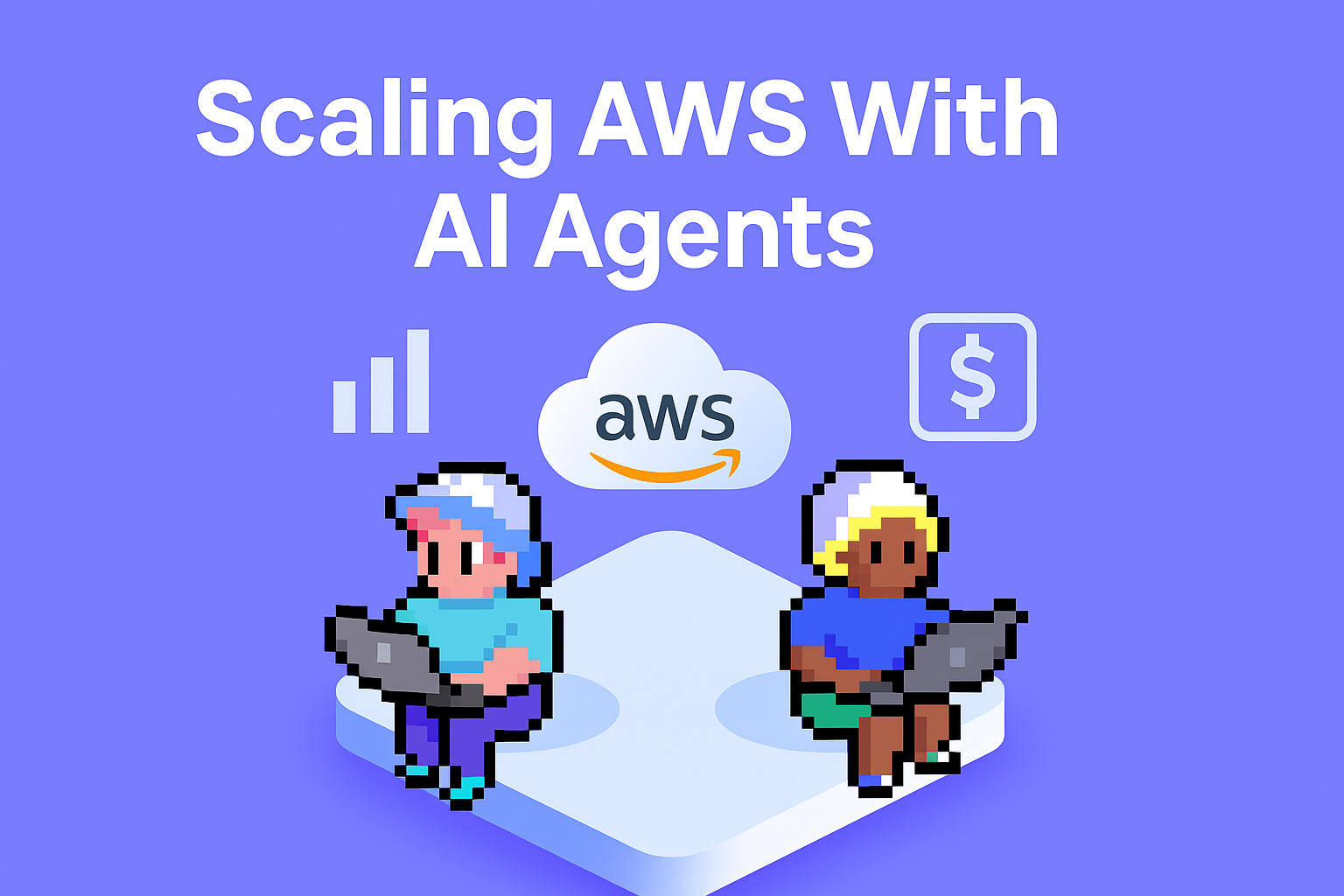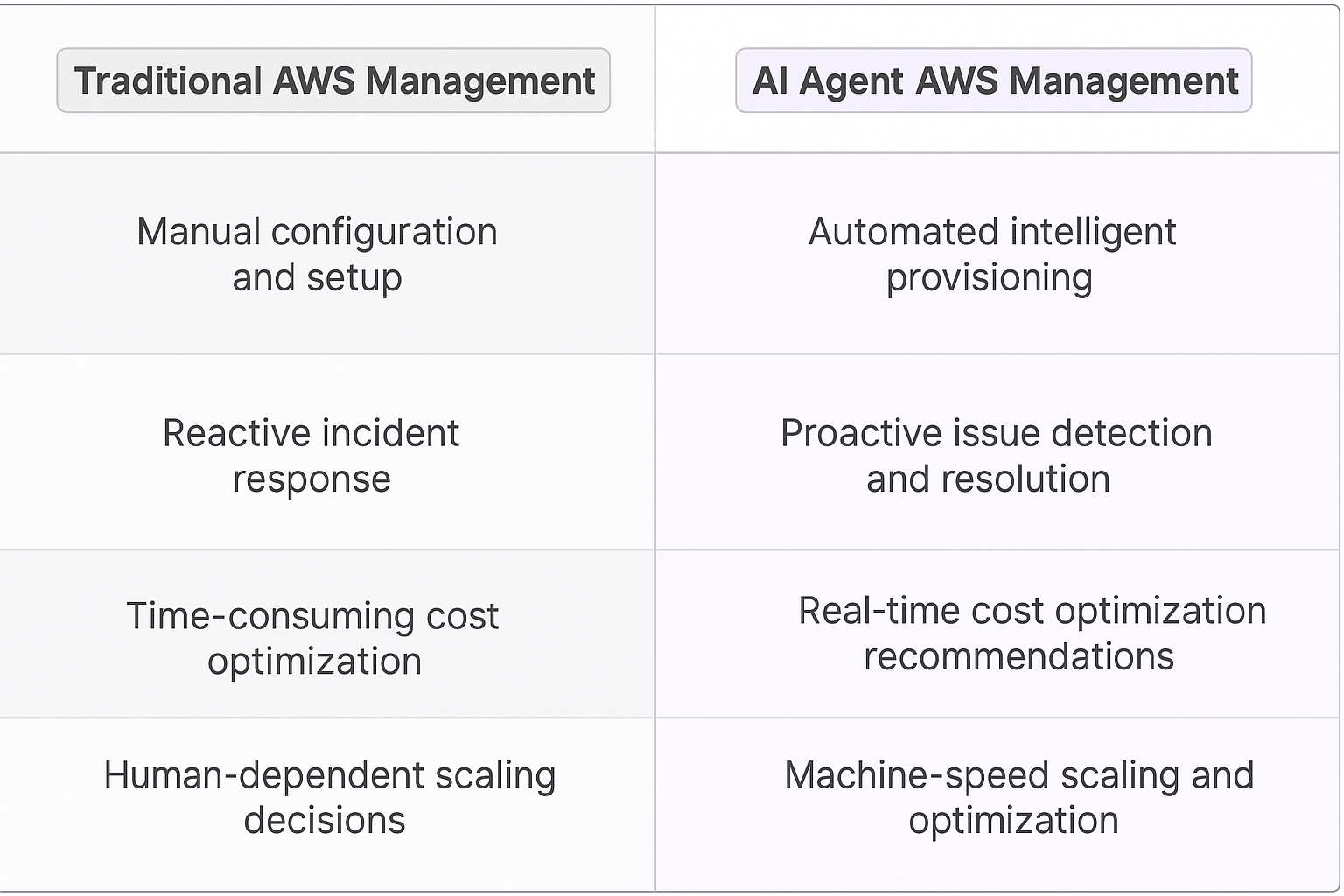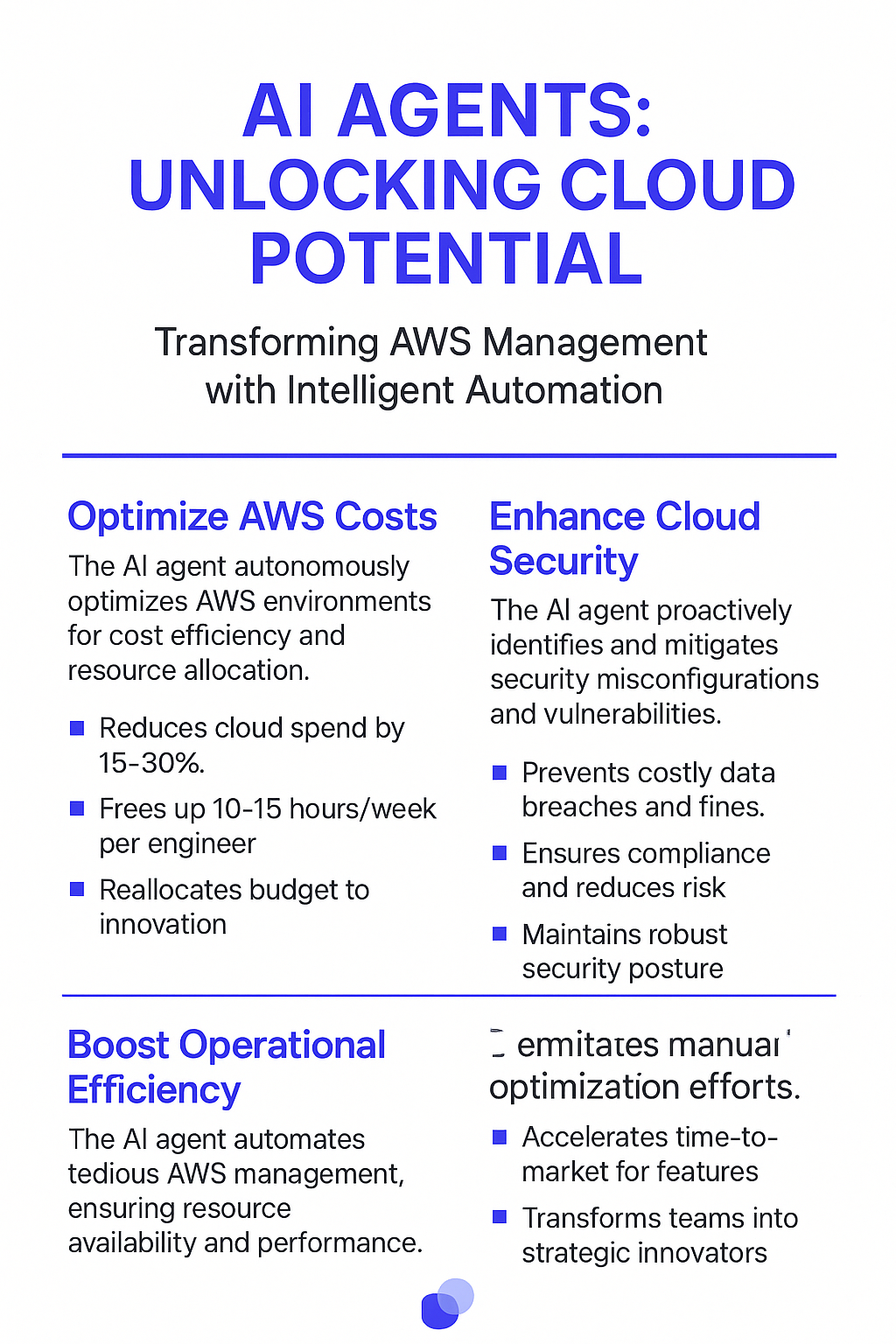AWS AI Agents
Understanding AWS
What is AWS?
Amazon Web Services (AWS) is the 800-pound gorilla of cloud computing. It's a comprehensive, evolving cloud computing platform that offers a mix of infrastructure as a service (IaaS), platform as a service (PaaS), and packaged software as a service (SaaS) offerings. AWS provides a vast array of services, from basic stuff like compute power and storage to cutting-edge technologies like machine learning and artificial intelligence. It's the playground where startups and Fortune 500 companies alike come to build, experiment, and scale their digital dreams.
Key Features of AWS
AWS isn't just another cloud provider; it's a Swiss Army knife for the digital age. Here are some standout features:1. Elasticity: Scale up or down on demand. It's like having a rubber band for your infrastructure.2. Pay-as-you-go pricing: Only pay for what you use. It's the buffet model of cloud computing.3. Global reach: With data centers worldwide, you can deploy globally in minutes.4. Security: AWS offers a robust set of tools to keep your data fort knox-level secure.5. Diverse service catalog: From basic storage to quantum computing, AWS has a service for almost every digital need.6. Integration: AWS services play nice with each other, allowing you to build complex, interconnected systems with ease.7. Innovation at pace: AWS is constantly rolling out new services and features, keeping you at the cutting edge of tech.

Benefits of AI Agents for AWS
What would have been used before AI Agents?
Before AI agents entered the scene, AWS users were stuck in a labyrinth of documentation, forums, and support tickets. It was like trying to navigate San Francisco without Google Maps – doable, but painfully inefficient. DevOps teams spent countless hours sifting through AWS's vast service catalog, piecing together solutions like a complex jigsaw puzzle. The learning curve was steep, and the cognitive load was heavy.
Traditional methods involved manual configuration, trial-and-error approaches, and relying heavily on human expertise. This often led to suboptimal resource allocation, security vulnerabilities, and missed opportunities for cost optimization. It was a world where scaling meant scaling human effort linearly with infrastructure growth – a model that simply doesn't cut it in the cloud-native era.
What are the benefits of AI Agents?
Enter AI agents for AWS – they're like having a seasoned AWS solutions architect on speed dial, but one that never sleeps and operates at machine speed. These digital teammates are game-changers, transforming how we interact with and leverage AWS services.
First off, AI agents dramatically flatten the learning curve. They act as intelligent intermediaries, translating complex AWS concepts into actionable insights. This democratizes cloud expertise, allowing teams to punch above their weight class in terms of infrastructure management.
But it's not just about knowledge – it's about execution. AI agents can proactively monitor your AWS environment, spotting inefficiencies and suggesting optimizations in real-time. Imagine having a system that not only alerts you to potential cost overruns but also provides tailored recommendations for rightsizing instances or leveraging spot instances – that's the power of AI agents in action.
Security gets a major boost too. These agents can continuously audit your AWS setup against best practices and compliance standards, flagging potential vulnerabilities before they become actual problems. It's like having a tireless security team working 24/7 to keep your cloud fortress impenetrable.
Perhaps most importantly, AI agents enable a level of automation that was previously unthinkable. They can handle routine tasks, freeing up your team to focus on high-value, strategic work. This isn't just about saving time – it's about unlocking human potential and driving innovation.
The end result? Faster deployments, more reliable systems, optimized cost optimization, and a team that can focus on building the future instead of firefighting the present. In the high-stakes world of cloud computing, AI agents for AWS aren't just nice to have – they're becoming essential for staying competitive.
Potential Use Cases of AI Agents with AWS
Processes
AWS AI agents are poised to transform how we interact with cloud infrastructure. These digital teammates can handle complex processes that traditionally required deep AWS expertise. For instance, they can orchestrate multi-step deployments across various AWS services, ensuring each component is optimized and secure.
One killer app for AWS AI agents is in cost optimization. They can continuously analyze your AWS usage patterns, spot inefficiencies, and suggest architectural changes to reduce your cloud bill. It's like having a cost-conscious cloud architect working 24/7 on your behalf.
Another game-changing process is automated incident response. When shit hits the fan (and it always does), AWS AI agents can spring into action. They'll diagnose issues, implement fixes, and even write up post-mortems. This isn't just about saving time; it's about radically improving your mean time to recovery (MTTR).
Tasks
On a more granular level, AWS AI agents excel at handling repetitive tasks that eat up DevOps engineers' time. Think about provisioning new environments, setting up IAM roles, or configuring VPCs. These digital teammates can knock out these tasks in seconds, freeing up your human talent for higher-value work.
One task that's particularly ripe for AI assistance is log analysis. AWS generates a ton of logs, and sifting through them is a pain. AI agents can continuously monitor these logs, flagging anomalies and potential security threats in real-time. It's like having a tireless security analyst who never misses a beat.
Another key task is data pipeline management. AWS AI agents can optimize your ETL processes, ensuring data flows smoothly between S3, Redshift, and your analytics tools. They can even suggest schema improvements or identify data quality issues before they become problems.
The potential of AWS AI agents reminds me of the early days of cloud computing. Just as the cloud democratized access to scalable infrastructure, these AI agents are democratizing access to AWS expertise. They're not replacing human engineers, but they're certainly changing the game. The companies that figure out how to leverage these digital teammates effectively will have a significant competitive advantage in the years to come.

Industry Use Cases
AI agents in AWS are reshaping industries with their adaptability and power. They're not just tools; they're digital teammates that can transform how businesses operate. Let's dive into some concrete examples of how these AI agents are making waves across different sectors, showing off their ability to enhance workflows and drive innovation.
From finance to healthcare, retail to manufacturing, AWS AI agents are proving their worth by tackling complex tasks, analyzing vast datasets, and providing insights that were previously out of reach. These aren't just incremental improvements – we're talking about fundamental shifts in how companies approach problems and create value.
In the following examples, you'll see how AWS AI agents are being leveraged to solve real-world challenges, boost productivity, and unlock new opportunities. These use cases demonstrate the tangible impact of AI integration, moving beyond hype to deliver measurable results. Whether it's through data pipeline management or advanced log analysis, these agents are becoming indispensable across industries.
Transforming Healthcare with AWS AI Agents
Let's talk about how AWS AI Agents are reshaping the healthcare landscape. It's not just about fancy tech – we're witnessing a fundamental shift in patient care and operational efficiency.
Take a major hospital network I recently consulted with. They were drowning in administrative tasks, and patient wait times were through the roof. Enter AWS AI Agents. These digital teammates became the backbone of their patient management system, handling everything from appointment scheduling to follow-up reminders.
But here's where it gets interesting: These AI Agents aren't just glorified chatbots. They're analyzing patient data in real-time, flagging potential issues before they become critical. Imagine a system that can predict which patients are likely to miss their appointments or who might need additional care based on their medical history and current symptoms. That's the level of sophistication we're dealing with.
The results? A 30% reduction in administrative overhead and a 25% decrease in patient wait times. But the real kicker is the improvement in patient outcomes. By identifying at-risk patients early, the hospital has seen a significant drop in readmission rates.
This isn't just about efficiency – it's about saving lives. And it's happening right now, not in some distant future. AWS AI Agents are becoming an integral part of the healthcare ecosystem, working alongside human professionals to provide better, more personalized care through advanced data management.
The potential here is massive. As these AI Agents continue to learn and evolve, we're looking at a future where predictive healthcare becomes the norm, not the exception. It's a prime example of how AI can augment human capabilities in critical sectors, creating value that goes far beyond the bottom line.
Reinventing Financial Services with AWS AI Agents
The financial services industry is ripe for disruption, and AWS AI Agents are leading the charge. I've been tracking this space closely, and the transformation is nothing short of remarkable.
Take the case of a mid-sized investment firm I advised last year. They were struggling with information overload and decision latency. Enter AWS AI Agents. These digital teammates became their secret weapon in navigating the complexities of global markets.
Here's where it gets interesting: These AI Agents aren't just crunching numbers. They're synthesizing vast amounts of data from multiple sources - news feeds, social media sentiment, economic indicators - and providing real-time insights that human analysts simply couldn't match in speed or scope.
The impact? A 40% increase in trading efficiency and a 20% boost in portfolio performance. But the real game-changer is in risk management. By continuously monitoring market conditions and portfolio exposure, these AI Agents can flag potential risks before they materialize, allowing for proactive rather than reactive decision-making.
What's fascinating is how this technology is democratizing sophisticated financial analysis. Tools that were once the exclusive domain of Wall Street titans are now accessible to smaller firms and individual investors. It's leveling the playing field in ways we've never seen before.
But here's the kicker: As these AI Agents learn and evolve, they're not just mimicking human analysts - they're developing novel strategies and insights that humans might never have conceived. We're witnessing the emergence of a new kind of financial intelligence, one that combines the best of human expertise with machine learning capabilities.
The implications are profound. We're moving towards a future where AI-driven financial services become the norm, offering personalized, data-driven advice at scale. It's not just about making money - it's about fundamentally reimagining how we interact with and understand financial markets.
This is just the beginning. As AWS continues to push the boundaries of what's possible with AI, we can expect to see even more innovative applications in the financial sector. The firms that embrace this technology early will have a significant competitive advantage. Those that don't risk being left behind in an increasingly AI-driven financial landscape.

Considerations and Challenges for AWS AI Agent Implementation
Implementing AWS AI agents isn't a walk in the park. It's more like navigating a complex maze while juggling flaming torches. Let's dive into the nitty-gritty of what you're up against.
Technical Challenges
First off, you're dealing with a steep learning curve. AWS's ecosystem is vast and ever-evolving. You'll need to master services like Amazon SageMaker, AWS Lambda, and Amazon Comprehend. It's not just about understanding these tools individually, but how they interplay to create a cohesive AI agent.
Data management is another beast. You're looking at handling massive datasets, ensuring data quality, and maintaining data privacy. Remember, your AI agent is only as good as the data it's trained on. Garbage in, garbage out.
Then there's the integration headache. How do you seamlessly weave your AI agent into existing systems without disrupting operations? It's like performing open-heart surgery while the patient is running a marathon.
Operational Challenges
On the operational front, cost management is a big one. AWS's pricing model can be as complex as a Rubik's cube. You'll need to optimize your resource usage to avoid burning through your budget faster than a Tesla on Ludicrous mode.
Scaling is another consideration. As your AI agent grows smarter and more popular, can your infrastructure keep up? It's not just about handling increased load, but also maintaining performance and reliability as you scale.
Let's not forget about the human element. Your team needs to be up to speed with the latest in AI and AWS technologies. This isn't just a one-time training; it's an ongoing process of learning and adaptation.
Lastly, there's the ethical dimension. As your AI agent becomes more sophisticated, you'll need to grapple with issues of bias, transparency, and accountability. It's not just about what your AI can do, but what it should do.
Implementing an AWS AI agent is a journey filled with challenges, but also immense opportunities. It's not for the faint of heart, but for those willing to push the boundaries of what's possible in the digital realm.
The Future of Cloud Computing: Riding the AI Wave
AWS AI agents are not just another tech trend; they're a fundamental shift in how we approach cloud computing. These digital teammates are redefining what's possible in the AWS ecosystem, from automating complex tasks to providing real-time insights that were previously unattainable.
The impact of AWS AI agents spans across industries. In healthcare, they're improving patient outcomes and operational efficiency. In finance, they're democratizing sophisticated analysis and reshaping risk management. These aren't just incremental improvements; we're talking about paradigm shifts in how businesses operate and create value.
However, implementing AWS AI agents isn't a walk in the park. It comes with significant technical and operational challenges, from data management to ethical considerations. But here's the thing: these challenges are not roadblocks, they're opportunities for innovation.
Looking ahead, the potential of AWS AI agents is massive. As they continue to evolve and learn, we're moving towards a future where AI-driven cloud operations become the norm. The companies that figure out how to leverage these digital teammates effectively will have a significant competitive advantage.
In the end, AWS AI agents are more than just tools; they're catalysts for transformation. They're changing the game in cloud computing, and the ripple effects will be felt across industries for years to come. The future of cloud computing is here, and it's powered by AI. Are you ready to ride this wave? With proper risk management strategies in place, organizations can harness this transformative technology safely and effectively.










